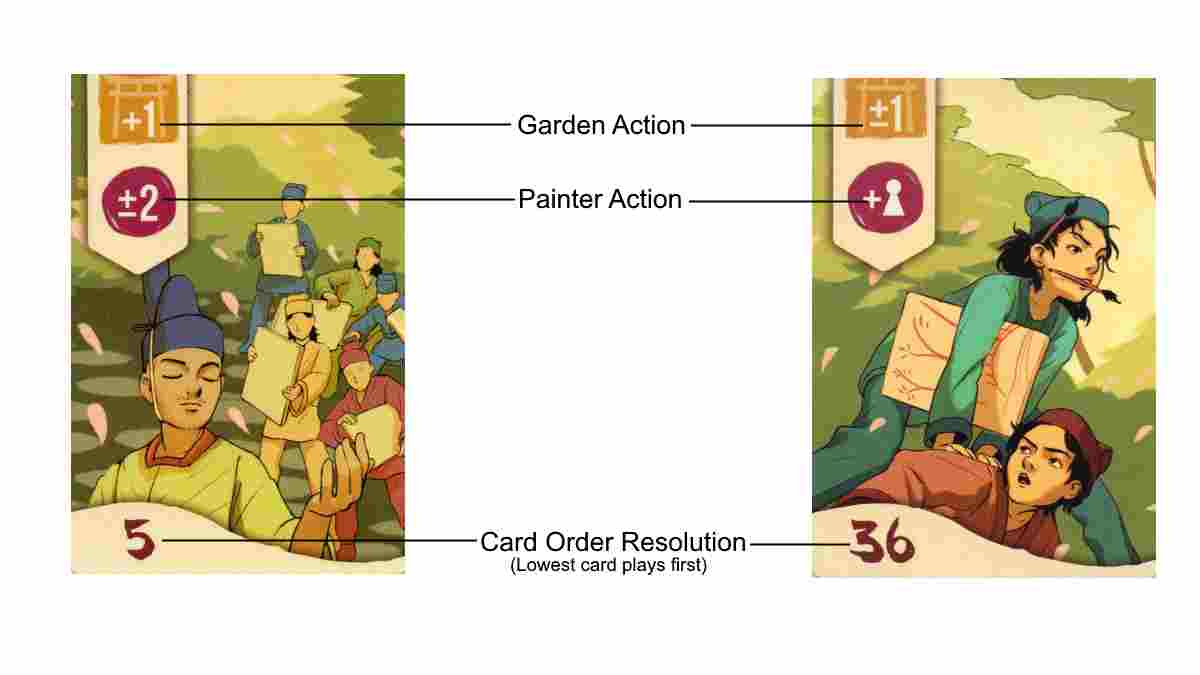 Osprey Games is carving itself a niche with beautifully packaged small-boxed games. Games that are thoughtful and often themed around a non-western setting. I’ve reviewed a couple of them on GeekDad: Ravens of Thri Sahashri and, last year, Shaharazad was awarded GeekDad Approved status. This year sees the release of Sakura by Reiner Knizia.
Osprey Games is carving itself a niche with beautifully packaged small-boxed games. Games that are thoughtful and often themed around a non-western setting. I’ve reviewed a couple of them on GeekDad: Ravens of Thri Sahashri and, last year, Shaharazad was awarded GeekDad Approved status. This year sees the release of Sakura by Reiner Knizia.
Sakura is a great game, also good enough for me to consider it GeekDad Approved. Read on to find out why.
What Is Sakura?
Sakura is a push-your-luck game for 2–6 people. It takes 15–30 minutes to play. Players take the role of court painters vying to paint the best portrait of the emperor in his garden. Those who stay closest to him will be able to paint the best picture, but beware: if you get too close and bump into the exalted emperor, you will be sent to the back of the queue and lose a token. At three points during the game, players are awarded tokens depending on how close they are to the emperor. The player with the most tokens at the end of the game is the winner.
The game has several elements that are found in other games, combined to make a new, satisfying whole. Sakura reminds me of Kingdomino, Gravwell, and Tokaido.

Sakura Component Overview
Being a small box game, there aren’t that many elements to Sakura:
- 1 Board, depicting the path through the emperor’s garden.
- 6 Player pawns in six different colors.
- 1 Emperor pawn.
- 60 Movement cards.
- 6 X 5 tokens that match the player pawns color.
- Additional scoring tokens in a neutral color.
There was a small problem with the board. It doesn’t lie flat very well after having been folded away in the box and is stubborn about flattening out entirely. We resorted to using a couple of small weights to help push it down. Despite the board’s camber, it is still possible to play the game, even if you don’t weigh it down.

The components themselves are of good quality. The pawns are a nice size, with the emperor standing taller than his painters, as one might expect. The cards are smooth on both sides and made from good card stock. Both sides of the cards have pleasing faces. The Japanese style flower picture on the reverse side is a nice touch and the thematic “competitive painters” aesthetic of the playing faces are appealing, adding to Sakura’s quirky flavor.
The tokens are pressed cardboard and are every bit as good as you’d expect from a company like Osprey. It’s slightly confusing as to why there are specific tokens in each player color. As far as I can tell, there is no reason to be. Each player starts with 5 tokens, only because of the possibility that they may lose them before arriving at the first sakura square (more on that later). The tokens are merely a way of keeping score and color seems to be irrelevant.
Sakura is GeekDad Approved!
How do I play Sakura?
Setup is simple. All the player pawns start behind the entrance gate. The emperor pawn starts on the torii space, 5 spaces away from the gate (7 spaces in a 5 or 6 player game).
Each player receives 5 tokens in their color and is dealt 5 cards. The remaining cards are placed face down by the side of the board. Everybody is now ready to play Sakura.
What happens in a round of Sakura?
Each round, players will choose a card from their hand. The card chosen will control their movement in some way. Cards are kept hidden until all players are ready. Once everybody has picked, the cards are simultaneously revealed. The actions on the cards are then resolved in turn.
In what order are cards resolved?
Each card has a number in the bottom left-hand corner, from 1-60. Cards are resolved in the order lowest to highest. So card 1 is resolved before card 10, and card 10 before card 46.
Cards have two “actions” on them. When it’s a player’s turn to resolve their card, they resolve both actions, starting with the action at the top of the card, the garden action.

What are the card actions?
The first resolved action is the garden action. This generally moves the emperor pawn There are 6 different symbols that denote emperor movement and they are resolved as follows.
- “+ 1”: Move the Emperor forward 1 space.
- “+ 2” : Move the Emperor forward 2 space.
- “± 1”: Choose whether the Emperor moves forward or backward 1 space.
- “-2” (in a green triangle): Move the painter closest to the Emperor back two spaces.
- “+2” (in an inverted red triangle): Move the painter furthest from the Emperor forward two spaces.
If at any point the emperor moves into a player pawn, (or a player leaps over his opponents into the Emperor, thanks to a red triangle) that pawn is moved back three spaces and the player loses one token.
NOTE: Only empty squares are counted for movement. Other players’ pawns are jumped over for free, in either direction. This means that even the player at the back of the pack can still suddenly find themselves perilously close to the Emperor.

The second action, the “painter action,” will result in the movement of the card player’s pawn. The painter action is resolved as follows.
- Red circles containing +1, +2, or +3: Move your painter 1, 2, or 3 spaces forward.
- Red circles with ±1, ±2, ±3: Choose whether your painter moves 1, 2, or 3 spaces, forward or backward.
- A symbol with a pawn with an arrow sweeping over it: Place your painter on the first available empty space in front of you.
- +Pawn symbol: Count the number of painters between you and the Emperor. Move one space for each.
If at any point a player pawn moves into the Emperor pawn, the movement finishes. The pawn moves back three spaces and the player loses one token.
Once a player’s card has been resolved, the turn moves to the player with the next highest numbered card.

Once all players have resolved their cards, the cards used in the round are discarded. A replacement is dealt to each player so that everybody starts the next round with 5 cards.
What is a Sakura space?
Sakura is the Japanese word for cherry blossom. The Sakura spaces are where the emperor stops to admire his garden.
Play continues way until the emperor pawn reaches one of the three “Sakura” spaces. The moment the emperor reaches a Sakura space, play stops. The rest of the card is not resolved and any cards not yet resolved this round are discarded (this means some players may not move during that round). Players then score tokens depending on how close to the emperor they are.
Only the three players closest to the emperor score any tokens (4 players in 5- or 6-player game). 3 tokens are awarded to the closest player, 2 to the next player and 1 to the third closest player (and 1 for the 4th, if applicable). Each Sakura space is only scored once per game. If the emperor ends up moving back past a Sakura space that has already been scored, it is from then on counted as normal tile. The final Sakura space, the shrine, scores an additional point for the player closest to the emperor (4 points in all).
After the Sakura space has been resolved, all players draw a new card and play continues as normal.

Why Play Sakura?
Sakura is quick to play and lots of fun. The essence of the game is simplicity itself, but playing provides a host of things to think about. Despite that, it’s not a game that gets bogged down with analysis paralysis. Whilst you need to think a little about your tactics, there’s no point in doing too deep an analysis because your opponents will inevitably foul up your best-laid plans. The game is at its most rewarding when everybody plays quickly. The only flaw I’ve found with the game is the problem with the board not flattening properly.
I’m not sure of the timeline of board game mechanics evolution, but Sakura feels as though it’s taken elements of great games and melded them into something new and interesting. The lowest-card-plays-first mechanic is straight from Kingdomino. It adds an additional challenge of predicting where you’re going to be at the point at which you actually get to make your move. You may have the perfect card in your hand but if it’s number 57, the world is going to be a different place by the time you get to resolve your actions.

This leads inevitably to Gravwell levels of hilarity, where your brilliant prepared move, sees you sailing backwards past your competitors as they completely outmaneuver you. That this outmaneuvering is often entirely unintentional, just adds to the amusement. Finally, there’s the procession of pawns and the queuing up at the various sakura spaces. This slow race to the front is reminiscent of Tokaido.
Sakura is a great palate cleanser between longer, more serious games. It plays well on game night. I took Sakura along to one of our regular sessions, which has a variety of gamers from novice to serious. It was a universal hit. My children have played and enjoyed Sakura. Because the mechanics of the game are easily explained, it’s accessible for younger players too. All in all, Sakura is a great small box game that bears many repeat plays. It’s good enough for me to consider it GeekDad Approved.
Click here to see all our tabletop game reviews.
If you’d like to stay up-to-date with all of our tabletop gaming coverage, please copy this link and add it to your RSS reader.
Disclosure: GeekDad received a copy of this game for review purposes.





